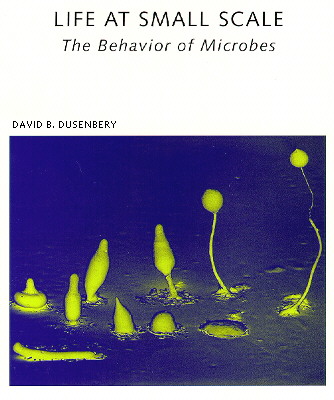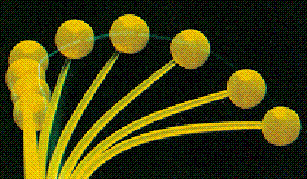

Looking through a microscope at the myriad of micro-organisms darting about, it is easy to not question their behavior. After all, they do what you would expect -- many move and seem to do so with purpose. They eat and are eaten and react to each other and to changes in their environment. However, in a sense, accepting this behavior without asking why or how is doing something akin to practicing anthropomorphism. But instead of imposing human behavior and values on microbes, it is imposing the explanations that apply to more advanced organisms that have numerous specialized cells and perhaps most importantly, well-developed nervous systems. It is also assuming the laws of physics apply in the same way on a microscopic scale as they do on a larger one. Neither premiss is necessarily correct.
Life at Small Scale does not make these errors. This fascinating and well written book asks questions about how and why these creatures behave the way they do. Once these questions are asked, their importance seems almost obvious except that I did not think of many of these questions before hand. For example, how does an organism without a nervous system (or with a very rudimentary one), without intelligence or sight as we would normally define it, without a specialized circulatory or digestive system and seemingly without any of the other senses that higher life forms have do such things as:
1. Move at all,
2. Move in a particular direction,
3. Detect obstacles and move around them,
4. Process food, get the necessary nutrients to the various parts
of its body and dispose of the waste,
5. Sense its prey or mate (when sexual reproduction is involved) at a distance,
6. "Know" that it has found its prey or a mate,
7. Avoid becoming prey,
8. Keep track of time,
9. Identify a source of light,
10. Distinguish day and night,
11. "Know" which way is up and which down,
12. Follow the earth's magnetic field; and
13. Possibly "learn" from experience.
Yet as many of our own observations indicate and as the book relates, microbes do (or appear to do) these things. Further, even if one has a simple answer, that answer raises more questions. For example, as to how microbes move, one might respond that some microbes do so with cilia or flagella. But this raises the question of how the cilia or flagella are moved without muscles and how is this motion done in a necessarily co-ordinated fashion without benefit of a nervous system.
I found that just the raising of these questions and the discussion of the behavioral background of these creatures which raised the questions in the first place were fascinating exercises. But of course the reader wants to know the answers. You will not find all of the answers to the "hows" and "whys" in this book because some are yet to be discovered. However, because of the 1996 publication date, Life at Small Scale provides the results of recent research that answers many of these questions or provides strong insights as to which direction the answers may eventually develop. An example is the rotary motor that powers the flagella in some bacteria. It is the only rotary motor found so far in living creatures and only recently identified (when I say "rotary", I mean that it contains a shaft that spins continuously through 360 and beyond similar to the shaft of an electric motor). The author provides an explanation of why such a motor may be possible only at the bacterial scale.
Further, the author is not hesitant to suggest possible theories where experimental evidence is still lacking. I hope the author will publish an updated edition in ten years that will fill in more pieces of the puzzles discussed in this book but I would not wait for this to happen. There is more than enough in the current edition to engross anyone interested in the microscopic world.
The text alone justifies the purchase of this book. However, as an added bonus, it is beautifully and profusely illustrated in color. An example is the cover of the book set out at the beginning of this review. It contains a beautiful photograph of the various life stages of the slime mold Dictyostelium discoideum. The cells are first in an individual amoeba form. They then aggregate into a slug which moves to an appropriate location and forms a thin stalk at the top of which forms a fruiting body. This releases spores into the air.
 Another photograph of the many which appear in Life
at Small Scale is shown at the left. It illustrates a Phycomyes
sporangiophore responding to light.
Another photograph of the many which appear in Life
at Small Scale is shown at the left. It illustrates a Phycomyes
sporangiophore responding to light.
Just to prove that I really am a budding critic, I had to come up with one small criticism of this book. The author seems to assume an almost divine infallibility with respect to each choice he finds evolution has made. In other words, natural selection is an almost perfect process and each manifestation of nature's choices must be the most efficient and most practical choice or it would not show itself. He does not consider the possibility that an organism's current status may be the result of either (1) a poor choice that natural selection has not yet weeded out or (2) a choice that while not beneficial and occasionally harmful, is not harmful enough to make a real difference (e.g. the residual appendix in man). In other words, chance may play a part in forming the creatures of this earth. However, it is easy to understand the author's bias in this regard because so many discoveries of features which initially appear to have no benefit to an organism subsequently are found to confer real advantage. Further, I am not sure anyone is in a position to argue conclusively that divine purpose had nothing to do with the process of evolution.
Regardless of this small weakness (if it is that), I think everyone who reads this book will come away with a better appreciation of the exquisite variety and complexity of life on this planet and will also as a result ponder its causes. As Emerson states:
"Nature is a language, and every new fact that we learn is a new word; but rightly seen, taken all together, it is not merely a language, but the language put together into a most significant and universal book. I wish to learn the language, not that I may learn a new set of nouns and verbs, but that I may read the great book which is written in that tongue."
--From the Journals of Ralph Waldo Emerson
November 2, 1833
Life at Small Scale helps us read and
understand this "significant and universal book"
written in the language of nature to which Emerson refers. If it
is not obvious from what I have said up to this point, I am
bubbling over with enthusiasm for Life at Small Scale.
This book is highly recommended! I cannot imagine anyone
interested in the microscopic world not either owning a copy or
borrowing it from the library.
David Dusenbery is a professor of Biology at the Georgia Institute of Technology in the state of Georgia in the United States. He has a Ph.D. in biophysics. The author grew up in the Northwestern United States in Vancouver, Washington (which is different than Vancouver, British Columbia in Canada). The State of Washington is in the very Northwest corner of the continental United States. It is sometimes confused with that other Washington--the city--where the President lives (the state tourist agency likes to say that our "Washington Monument" is Mt. Rainier, the tallest peak in the state and a dormant volcano--however, as Mt. St. Helens reminded us, dormant volcanoes are sleeping giants that sometimes wake up). Ancestors of the author's mother crossed the plains in a covered wagon and homesteaded in the Willamette valley in Oregon (the state on Washington's southern border).
The author was kind enough to review a draft of this review for factual errors (he had no say on my comments on the book which are entirely my own). He has indicated that he would welcome comments and questions from readers of his book. He may be reached at the following e-mail address:
david.dusenbery@biology.gatech.edu
I would appreciate getting a copy of any such correspondence (I would like to see if others enjoy this book as much as I have). Also, please feel free to send me any comments or critiques of this review directly. I may be reached at the following e-mail address:
As may be obvious from the spelling (e.g. the
word "color" as opposed to "colour") and not
using the word "whilst", I, like the author, also
reside in the United States. I am an attorney (definitely a
solicitor rather than a barrister) with a life-long interest in
science. I have no association with either the author or
publisher (I am just an enthusiastic fan of Life at Small
Scale). I live in Seattle which is also in the State of
Washington. Seattle is on the western side of the state as is
Vancouver, Washington (see above). Western Washington has a
climate and flora remarkably like England so I feel right at home
when visiting England in the middle of a drizzling rain.
Life at Small Scale is part of the Scientific American Library series distributed by W. H. Freeman and Company of New York, N.Y. (U.S.) and Houndmills, Basingstoke (U.K.) and may be purchased or ordered through most bookstores. It has a suggested list price of $32.95 in the United States and ú19.95 in the United Kingdom. Looking quickly, I found the following on-line sources for the book:
Amazon http://www.amazon.com
Barnes & Noble http://www.BarnesandNoble.com
Blackwell's http://www.comlab.ox.ac.uk/archive/ox/blackwells.html
Internet Bookshop http://www.bookshop.co.uk/
I am sure there are many other sources in the
U.S., the U.K. and the rest of the world. W. H. Freeman and
Company is the distributor for the United States and Canada. In
Europe, Africa, the Middle East, India and South America it is W.
H. Freeman at Macmillan Press. It is distributed in Australia by
MacMillan Education Australia, in New Zealand by Macmillan
Publishers New Zealand Limited, in China and Hong Kong by
Macmillan Publishers (China) Ltd and in Japan by Macmillan
Shuppan K.K. I have a list of the distributors for other
countries. Please contact me by e-mail if you need one of these.
W. H. Freeman and Company informs me that the
publishing firm of Natuur & Techniek in the Netherlands has
acquired rights to the book in that country and is now having the
book translated into Dutch (editor Dr. Tom Kortbeek). The
publication is projected for January 1999.
The copyright to the photographs from Life at Small Scale used in this review belong to the following with whose permission they are gratefully used:
R.L. Blanton and M.J. Grimson, Department of Biological Sciences, Texas Tech University, Lubbock, TX 79409-3131, brrlb@ttacs.ttu.edu
David S. Dennison, Department of Biological Sciences, Dartmouth College, Hanover, NH, 03755-3576, David.S.Dennison@Dartmouth.EDU
Editor's Note: We thank David Goldstein for contributing this fascinating review to Micscape Magazine.
Please report any Web problems
or offer general comments to the Micscape Editor,
via the contact on current Micscape Index.
Micscape is the on-line monthly
magazine of the Microscopy UK web
site at Microscopy-UK